This is a bi-directional task.
Forward Direction
1. Translation
For each contour, calculate its moment. Then for each point in that contour, translate it about the moment i.e. contour.point[i] = contour.point[i] - contour.moment[i]. This moves all of the contour points to the origin.
PS: You need to keep track of each contour's produced moment because it will be used in the next section
2. Rotation
With the newly translated points, calculate their rotated rect. This will give you the angle of rotation. Depending on this angle, you would want to calculate the new angle which you want to rotate this contour by; this answer would be helpful.
After attaining the new angle, calculate the rotation matrix. Remember that your center here will be the origin i.e. (0, 0). I did not take scaling into account (that's where the pyramids come into play) when calculating the rotation matrix hence I passed 1.
PS: You need to keep track of each contour's produced matrix because it will be used in the next section
Using this matrix, you can go ahead and rotate each point in the contour by it as shown here*.
Once all of this is done, you can go ahead and calculate the Hausdorff distance and find contours which pass your set threshold.
Back Direction
Everything done in the first section, has to be undone in order for us to draw the valid contours onto our camera feed.
1. Rotation
Recall that each detected contour produced a rotation matrix. You want to undo the rotation of the valid contours. Just perform the same rotation but using the inverse matrix.
For each valid contour and corresponding matrix
inverse_matrix = matrix[i].inv(cv2.DECOMP_SVD)
Use * to rotate the points but with inverse_matrix as parameter
PS: When calculating the inverse, if the produced matrix was not a square one, it would fail. cv2.DECOMP_SVD will produce an inverse matrix even if the original matrix was a non-square.
2. Translation
With the valid contours' points rotated back, you just have to undo the previously performed translation. Instead of subtracting, just add the moment to each point.
You can now go ahead and draw these contours to your camera feed.
Scaling
This is were image pyramids come into play.
All you have to do is resize your template image by a fixed size/ratio upto your desired number of times (called layers). The tutorial found here does a good job of explaining how to do this in OpenCV.
It goes without saying that the values you choose to resize your image by and number of layers will and do play a huge role in how robust your program will be.
Put it all together
Template Image Operations
Create a pyramid consisting of n layers
For each layer in n
Find contours
Translate the contour points
Rotate the contour points
This operation should only be performed once and only store the results of the rotated points.
Camera Feed Operations
Assumptions
Let the rotated contours of the template image at each level be stored in templ_contours. So if I say templ_contours[0], this is going to give me the rotated contours at pyramid level 0.
Let the image's translated, rotated contours and moments be stored in transCont, rotCont and moment respectively.
image_contours = Find Contours
for each contour detected in image
moment = calculate moment
for each point in image_contours
transCont.thisPoint = forward_translate(image_contours.thisPoint)
rotCont.thisPoint = forward_rotate(transCont.thisPoint)
for each contour_layer in templ_contours
for each contour in rotCont
calculate Hausdorff Distance
valid_contours = contours_passing_distance_threshold
for each point in valid_contours
valid_point = backward_rotate(valid_point)
for each point in valid_contours
valid_point = backward_translate(valid_point)
drawContours(valid_contours, image)
It can be a little bit confusing at first especially with keeping track of every contours' respective moment and rotation matrices, but once you understand what is going on, it really is a very easy algorithm to implement.

